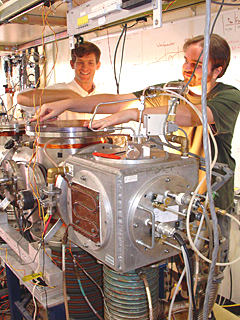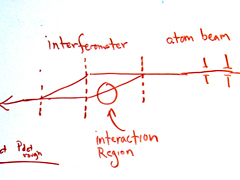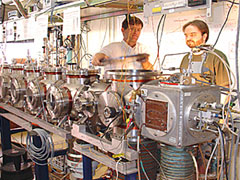Home > Press > Physicists Measure Tiny Force
Abstract:
Fast-moving atom shortens and lengthens depending on its distance from a surface
Physicists Measure Tiny Force That Limits How Far Machines Can Shrink
September 23, 2005By Lori Stiles
University of Arizona physicists have directly measured how close speeding atoms can come to a surface before the atoms' wavelengths change.
Their's is a first, fundamental measurement that confirms the idea that the wave of a fast-moving atom shortens and lengthens depending on its distance from a surface, an idea first proposed by pioneering quantum physicists in the late 1920s.

Alex Cronin (left) and John Perreault make an adjustment on the atom interferometer that they used in making the first direct measurement of atom wavelength shift caused by the van der Waals interaction.. Copyright © University of Arizona |
The measurement tells nanotechnologists how small they can make extremely tiny devices before a microscopic force between atoms and surfaces, called van der Waals interaction, becomes a concern. The result is important both for nanotechnology, where the goal is to make devices as small as a few tens of billionths of a meter, and for atom optics, where the goal is to use the wave nature of atoms to make more precise sensors and study quantum mechanics.
UA optical sciences doctoral candidate John D. Perreault and UA assistant professor of physics Alexander D. Cronin report the experiment in the Sept. 23 Physical Review Letters. The paper is online here (PDF).
Perreault and Cronin used a sophisticated device called an atom interferometer in making the measurement. Cronin brought the 12-foot-long device to UA from MIT three years ago. The atom interferometer was assembled over 15 years with more than $2 million in research grants from the National Science Foundation, the UA and the Research Corp. Now in Cronin's laboratory on the third floor of the UA's Physics and Atmospheric Sciences Building, the machine is one of only a half-dozen such instruments operating in the United States and Europe. It splits and recombines atom waves so that scientists can observe the position of the wave crests.

This simple sketch shows the placement of diffraction gratings - represented by the vertical dashed lines - that split and recombine atom waves. The gratings are about a meter apart. Copyright © University of Arizona |
"Our research provides the first direct experimental evidence that a surface 25 nanometers away (25 billionths of a meter) causes a shift in the atom wave crests," Perreault said. "It shows that the van der Waals interaction may be a small scale force, but it's a big deal for atoms."
Perreault and Cronin found that atoms closer than 25 nanometers to a surface are very strongly attracted to the surface because of the van der Waals interaction-- so strongly that the atoms are accelerated with the force of a million g's.
A "g" is a term for acceleration due to gravity. One g is an everyday experience -- it's the force a person feels from Earth's gravity. A roller coaster rider might feel 3 to 4 g's for brief moments during a ride. Fighter pilots can experience accelerations of up to 8 g for brief periods during tactical maneuvers, but can black out if subjected to 4 to 6 g's for more than a few seconds.
"We might say that when an atom is between 10 and 20 nanometers from a surface, it gets sucked toward the surface with a force a million times its weight," Cronin said. "And when it gets closer, it gets pulled even harder."

Cronin (left), Perreault and the atom interferometer. Copyright © University of Arizona |
The momentary acceleration of the atom as it passes by the surface is expressed in a famous equation which relates the speed of an atom to its wavelength, Cronin said. When atoms are accelerated and closer to the surface, their wavelengths become shorter. When farther from a surface, atoms return to their original wavelength. Perreault and Cronin used the atom interferometer to measure the wavelength shift.
Nanotechnology research aims to build much smaller transistors and motors, for example, than currently exist. Atom optics research aims to exploit the wave behavior of atoms in ways that will make more precise gyroscopes for navigation, gravity gradiometers for subterranean mapping and other field sensors.
"I think the impact of our work stems from the intersection of the fields of atom optics and nanotechnology," Perreault said. "It answers the question of how far you can miniaturize an atom optics device - for example, a device that guides atoms on a chip to form a very tiny interferometer - before this nano-interaction disrupts operations."
The idea that atoms behave as waves as well as particles goes back to 1924. They're called "de Broglie waves" for early 20th-century French quantum physicist Prince Louis-Victor de Brogli, who first proposed the concept of atom waves. Scientists have grappled with the dual wave-particle nature of atoms for decades and, in the 1990s, they began chilling atoms to near absolute zero and studying the wave properties of atoms in detail.
John D. Perreault
520-990-7208
johnp@physics.arizona.edu
Alexander D. Cronin
520-465-8459
cronin@physics.arizona.edu
Copyright © University of Arizona
If you have a comment, please Contact us.
Issuers of news releases, not 7th Wave, Inc. or Nanotechnology Now, are solely responsible for the accuracy of the content.
| Related Links |
| Related News Press |
Molecular Machines
![]() First electric nanomotor made from DNA material: Synthetic rotary motors at the nanoscale perform mechanical work July 22nd, 2022
First electric nanomotor made from DNA material: Synthetic rotary motors at the nanoscale perform mechanical work July 22nd, 2022
![]() Nanotech scientists create world's smallest origami bird March 17th, 2021
Nanotech scientists create world's smallest origami bird March 17th, 2021
![]() Giant nanomachine aids the immune system: Theoretical chemistry August 28th, 2020
Giant nanomachine aids the immune system: Theoretical chemistry August 28th, 2020
Molecular Nanotechnology
![]() Scientists push the boundaries of manipulating light at the submicroscopic level March 3rd, 2023
Scientists push the boundaries of manipulating light at the submicroscopic level March 3rd, 2023
![]() First electric nanomotor made from DNA material: Synthetic rotary motors at the nanoscale perform mechanical work July 22nd, 2022
First electric nanomotor made from DNA material: Synthetic rotary motors at the nanoscale perform mechanical work July 22nd, 2022
![]() Nanotech scientists create world's smallest origami bird March 17th, 2021
Nanotech scientists create world's smallest origami bird March 17th, 2021
Announcements
![]() NRL charters Navy’s quantum inertial navigation path to reduce drift April 5th, 2024
NRL charters Navy’s quantum inertial navigation path to reduce drift April 5th, 2024
![]() Discovery points path to flash-like memory for storing qubits: Rice find could hasten development of nonvolatile quantum memory April 5th, 2024
Discovery points path to flash-like memory for storing qubits: Rice find could hasten development of nonvolatile quantum memory April 5th, 2024
Tools
![]() Ferroelectrically modulate the Fermi level of graphene oxide to enhance SERS response November 3rd, 2023
Ferroelectrically modulate the Fermi level of graphene oxide to enhance SERS response November 3rd, 2023
![]() The USTC realizes In situ electron paramagnetic resonance spectroscopy using single nanodiamond sensors November 3rd, 2023
The USTC realizes In situ electron paramagnetic resonance spectroscopy using single nanodiamond sensors November 3rd, 2023
|
|
||
|
|
||
| The latest news from around the world, FREE | ||
|
|
||
|
|
||
| Premium Products | ||
|
|
||
|
Only the news you want to read!
Learn More |
||
|
|
||
|
Full-service, expert consulting
Learn More |
||
|
|
||








